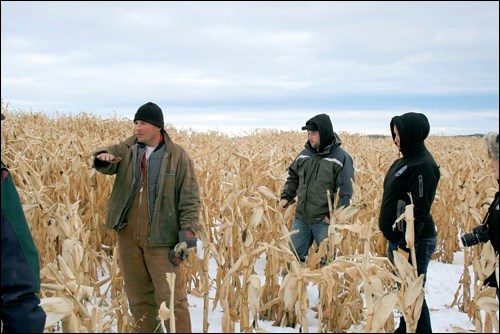To those individuals in the livestock industry, not all electric fences are created equal nor are all watering systems.
Twenty ranchers and specialists spent an afternoon at the Redberry Lake Biosphere Reserve Research and Education Centre learning about the various fencing and watering options available for livestock.
The workshop was a Redberry Lake Watershed Agri-Environmental Group Plan (AEGP) initiative that provided an opportunity for livestock producers to network with the specialists and learn about the aspects of effective fencing and watering systems.
Jason Williams, of Vintag Services Ltd., provided a hands-on electric fence presentation and demonstration, explaining how to achieve the best results from effective fencing systems.
Williams explained the importance of training cattle on electric fences in the summer to make winter usage effective. An important note was that an animal that is shocked in the nose or anywhere in front of its eyes will back up whereas an animal shocked behind its eyes such as the neck, back of head will cause it to bolt and move ahead. These are important aspects to consider when fencing.
Discussion was held regarding the importance of having all lines hot and linked together and the purpose of good grounding, regular maintenance issues with fencing, the most effective ways of fencing for swath grazing, troubleshooting and construction, including corner bracings. He confirmed that, due to an increased number of fencing supply manufacturers, competitive pricing has been advantageous to producers because quality has not been sacrificed with lower pricing costs.
A vital component to determining the location of electric fencing is to know where the water system will be, the wind source and protection, etc. Producers were presented with the opportunity to practise some fencing techniques on the replica of the fence.
Jeremy Brown, a rangeland agrologist with the Saskatchewan Watershed Authority, used actual Saskatchewan livestock producers' examples of all season livestock watering systems in his presentation. Livestock producers have become innovative and use a number of initiatives to provide quality water to their livestock and provide efficient cost-effective watering systems utilizing solar and wind power. Most of the systems were designed to address the problem of water contamination by livestock, soil erosion around the watering site, to improve water quality for livestock and to conserve wildlife habitat.
There are numerous grant packages available through local AEGP groups including the Redberry Lake organization. Brown continued by providing examples of cost and recovery of some projects indicating the efficiency and affordability of the projects to the livestock producers.
Two farms were visited on the field tour. Brian Yasieniuk near Hafford seeded 30 acres of poor cropland to oats and peas. The area was divided into three smaller parcels to be used for swath grazing. He estimated the cost to be between 80 and 90 cents per day and anticipates that with swath grazing, manure deposits will assist in improving the quality of the soil especially on the hills.
The second Hafford producer visited was Derrick Reid. Visitors were able to view the 30-acre plot of standing corn. The crop was seeded June 1 with a JD disc drill at 14 pounds and a ten-inch row space. He had previously added fertilizer on the hills at a rate of 40-50 pounds, which contributed to the crop reaching heights of 13 feet in areas. Reid plans to fence the area into smaller parcels for grazing although he did indicate that the corn crop could be swathed and made into silage.
Redberry Lake Watershed Agri-Environmental Group Plan anticipates hosting another winter workshop in the New Year.



